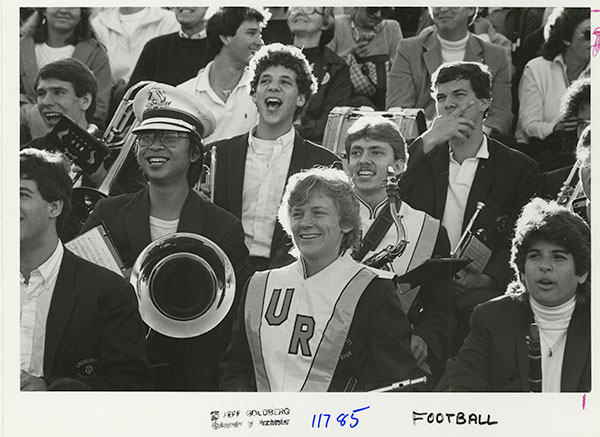Ask the Archivist
Ask the Archivist
Are reports of the marching band’s last hurrah greatly exaggerated?

STANDING OVATION: Tracing its origins to the early 20th century, by the mid-1980s, the University’s marching band moved from on-field performances at football games to a pep band that performed from the stands of Fauver Stadium, a tradition that continues today.
I was both surprised and very pleased to see the photo of Yellowjacket marching band members in the Fall 2022 issue of Rochester Review and both interested and sad to learn of the probable year of the band’s demise. I had been wondering for decades about when the band stopped functioning. Can you tell me why the band was discontinued?
—Harrington (Kit) Crissey Jr. ’66
Letters from alumni of the 1970s to Review also dispute the end date of the marching band proposed in the Fall 2022 issue, echoing a 1974 Campus Times letter from Michael Horowitz ’77: “Perhaps few people realize it, but the UR Marching Band is alive and well.” And so it would be—for about another decade.
The end of the band can probably be attributed to several factors, including competition from other activities and funding. Considered a student group providing a service to the University, the band could not receive Students’ Association funding and relied on an academic department—or in this case, two departments: music and athletics. In the September 20, 1982, Campus-Times, Sharmila Mathur ’85 reported that athletics became the band’s sole sponsor in spring 1981 but lacked a budget line to support it. With practice time in Fauver Stadium scarce, there was less stepping on the field and more pepping in the stands, and the baton was passed to the Varsity Pep Band, which continued to “create spirit in the fans by displaying spirit” as noted in the 1985 Interpres.
The origins of the University’s marching band—or perhaps the marching University Band—are no clearer than its coda.
In the Winter 1984 issue of Review, Frederick Fennell ’37E ’39E (MM), ’88 (Honorary) recounted his role in starting the band. “It was on a September afternoon just fifty years ago last fall when I, a pea-green Eastman School freshman . . . hiked over to the new River Campus to found the University of Rochester Marching Band.”
While hesitating to suggest Fennell was beating his own drum, there is considerable evidence that an organization known as the University Band, which performed and marched at football games, predated his Rochester arrival by some 25 years.
“Our University band should be the rallying point for our improved cheering and for the rendering of our really good college songs,” announced the November 18, 1908, Campus newspaper. In the years that follow, information about the band appears sporadically; each successive article announces a new band almost as though there had been no previous group.
Thus the October 1926 issue of Rochester Review trumpeted the news to alumni: “A praiseworthy addition to student life is a new University band, which made its initial appearance of the season at the Clarkson game, strikingly garbed in yellow jersies (sic), blue sailor trousers, and blue toques with yellow tassels . . . The band was organized by [Eastman School of Music professor] Sherman A. Clute . . . with the co-operation of Matthew D. Lawless, ’09 . . . and Eugene Loewenthal, ’28, student manager.”
The next Review issue pointed out that “quite aside from the rendition of music . . . [the band] is providing a definite tie-up between the college and the Eastman School of Music. Only about one-third of the band members are students of the college; the remaining two-thirds are from the School of Music.”
Home games were played at University Field, in the area where East High School is currently located—bounded by Culver Road, East Main Street, Ohio Street, and Atlantic Avenue. When the River Campus opened in the fall of 1930, the band, directed by Theodore Fitch, Class of 1922, joined the football team in the new Varsity Stadium. (The stadium was named for Edwin Fauver in 1951 and is now part of the Brian F. Prince Athletic Complex.)
Fennell took over the marching band in early 1934, and by all accounts (not just his own), the ensemble was a rousing success even after he passed on the baton about a decade later. In the off-season, he converted the group into a true University Band. Fennell directed its first concert in Strong Auditorium, won Eastman director Howard Hanson’s approval, and embarked on one of the University’s most illustrious careers.
Fennell’s reminiscence may resonate with that of other marching band alumni: “Whatever has happened to me in the fifty years since then, no matter where, when, or with whom, all dates from that beautiful early-autumn afternoon with my own first group. And I don’t intend, ever, to forget it.”
Ask the Archivist features a question for Melissa Mead, the John M. and Barbara Keil University Archivist and Rochester Collections Librarian.
Learn more
For more about the University’s history, visit the University Archives blog. To ask a question for Ask the Archivist, send an email to rochrev@rochester.edu with “Ask the Archivist” in the subject line.


